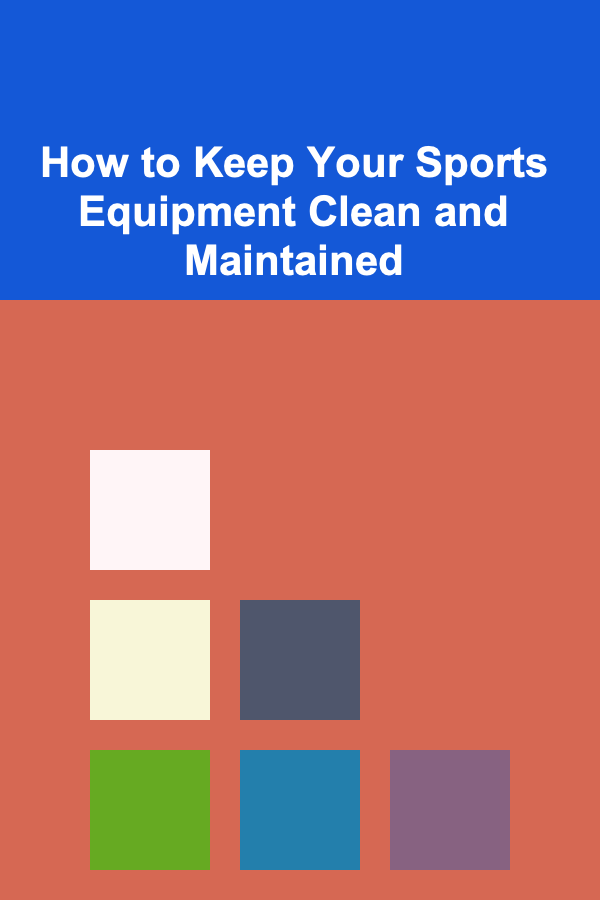
How to Keep Your Sports Equipment Clean and Maintained
ebook include PDF & Audio bundle (Micro Guide)
$12.99$5.99
Limited Time Offer! Order within the next:

Maintaining clean and well-kept sports equipment is essential for enhancing performance, ensuring safety, and prolonging the lifespan of your gear. Whether you are an amateur athlete, a dedicated professional, or a parent managing your children's sports needs, understanding how to properly care for your equipment is crucial. This comprehensive guide will explore effective cleaning practices, maintenance techniques, and best practices to keep your sports equipment in top condition.
Understanding the Importance of Equipment Maintenance
1. Enhances Performance
Properly maintained equipment performs better. For instance, clean and well-lubricated bicycle gears operate smoothly, improving speed and efficiency.
2. Ensures Safety
Worn-out or dirty equipment can lead to injuries. Regular inspections and cleanings help identify potential issues before they become dangerous.
3. Prolongs Lifespan
Keeping your gear clean and well-maintained extends its life. A well-cared-for football helmet can last multiple seasons, while neglected gear may need costly replacements.
4. Improves Hygiene
Sports equipment often comes into contact with sweat, dirt, and bacteria. Regular cleaning helps mitigate the risk of skin irritations and infections.
5. Increases Resale Value
If you ever decide to sell or donate your equipment, well-maintained items retain their value and appeal more to potential buyers or recipients.
Recognizing these benefits underscores the importance of implementing robust cleaning and maintenance practices.
General Cleaning Guidelines
1. Frequency of Cleaning
Establish a routine for cleaning your sports equipment based on use:
- After Each Use: Quick wipe-down of frequently used items like pads and shoes.
- Weekly: Thorough cleaning of equipment that sees regular use, such as bikes and balls.
- Monthly: Deep cleaning and inspection of all gear.
2. Use Appropriate Cleaning Supplies
Selecting the right cleaners is crucial. Always check manufacturer instructions for specific recommendations. Common supplies include:
- Mild Soap: Effective for general cleaning without damaging surfaces.
- Disinfectant Wipes: Convenient for quick cleaning of surfaces and handles.
- Soft Brushes: Ideal for scrubbing away dirt without scratching.
3. Dry Properly
Moisture can promote mold and mildew growth. Always dry equipment thoroughly after cleaning, especially items like shoes and gloves that can trap moisture inside.
4. Follow Manufacturer Instructions
Refer to the care labels and guidelines provided by manufacturers. Different materials require different cleaning methods; adhering to these ensures optimal care.
Adhering to these guidelines creates a solid foundation for keeping sports equipment clean.
Cleaning Specific Types of Sports Equipment
Different types of sports equipment have unique cleaning requirements. Below are tailored cleaning strategies for various categories:
1. Team Sports Equipment
1.1 Football Gear
- Helmets: Use a soft cloth and mild soap to wipe down the exterior. Avoid soaking, and let it air dry. Regularly inspect chin straps for wear.
- Pads: Hand wash in warm water with detergent. Rinse thoroughly and air dry.
- Uniforms: Wash as per fabric care instructions, typically in cold water to prevent shrinkage.
1.2 Basketball Gear
- Shoes: Remove laces and insoles, then clean with a damp cloth using mild soap. Air dry completely before reassembling.
- Balls: Wipe with a damp cloth after each use to remove dirt. Use specialized ball cleaners as needed.
1.3 Soccer Gear
- Cleats: Brush off any mud or dirt with a soft brush. Hand wash the upper part with soap and let them air dry.
- Shin Guards: Clean with a damp cloth and mild detergent, then rinse and dry thoroughly.
2. Individual Sports Equipment
2.1 Tennis Gear
- Rackets: Wipe down the frame and strings with a damp cloth after each use. Avoid using harsh chemicals that could damage strings.
- Tennis Balls: Store in a cool, dry place. Replace them if they lose their bounce or become fuzzy.
2.2 Golf Gear
- Clubs: Clean club heads with a brush and warm soapy water to remove dirt. Dry immediately to prevent rust.
- Bags: Vacuum or wipe down the exterior and wash the liner if removable, following care instructions.
3. Recreational Equipment
3.1 Bicycles
- Frame: Use a gentle soap solution and sponge to clean the frame. Rinse and dry thoroughly.
- Chain: Regularly clean and lubricate the chain using appropriate bike cleaning products to maintain smooth operation.
3.2 Skating Gear
- Skates: Wipe down blades after each use to prevent rust. Use a soft cloth for leather boots and check for loose parts regularly.
- Helmets: Clean with disinfectant wipes and allow to air dry.
By tailoring your cleaning approach according to the specific type of equipment, you ensure effective maintenance.
Regular Maintenance Practices
1. Inspect Equipment Regularly
Set aside time to perform thorough inspections of your gear to ensure everything is in good working order. Look for signs of wear, fraying, or other issues.
2. Lubricate Moving Parts
For equipment with moving parts (like bicycles or skateboards), apply appropriate lubricants regularly to ensure smooth operation. Follow manufacturer guidelines regarding frequency and types of lubricants.
3. Replace Worn-Out Items
Keep an eye out for items that need replacement. For example, old cleats that no longer provide support may increase the risk of injury during play.
4. Check for Tightness
Ensure screws, bolts, and fittings are secure, particularly in equipment like bikes and helmets. Loose components can lead to accidents.
5. Store Gear Securely
Make sure equipment is stored securely when not in use. This prevents accidental damage and makes it easier to keep things organized.
By incorporating these regular maintenance practices, you can extend the life of your sports gear significantly.
Storing Your Equipment Properly
The way you store your sports equipment can impact its condition over time:
1. Choose the Right Environment
Store equipment in a cool, dry place away from direct sunlight, which can deteriorate materials like rubber and plastics.
2. Use Protective Cases
Consider using protective cases for valuable items like rackets or clubs. This added protection minimizes the risk of damage during transport or storage.
3. Hang When Possible
Hanging items, such as bicycles or helmets, keeps them off the ground and reduces wear and tear caused by constant handling.
4. Organize Efficiently
Use shelves, bins, and racks to organize equipment effectively. Clearly label containers to facilitate easy access.
5. Follow Seasonal Storage Practices
For seasonal sports equipment, consider organizing gear by season. Store off-season items (like snow gear) in designated areas separate from year-round equipment.
Proper storage plays a vital role in maintaining the quality and longevity of your sports gear.
Signs of Wear and Tear
Being able to recognize the signs of wear and tear can save you from potential accidents or further damage:
1. Visual Inspection
Look for visible signs of damage, such as cracks, frayed straps, or discoloration. Address these issues promptly.
2. Functional Testing
Perform functional tests on gear to ensure it operates as intended. For instance, check if a tennis racket has lost tension in its strings or if a bike shifts correctly.
3. Smell Test
Foul odors can signal mold or rot, especially in items like shoes or pads. If you notice an unpleasant smell, it may be time to clean or replace the item.
4. Structural Integrity
For equipment like helmets and pads, check that the foam padding maintains its shape. Indentations or crumbling indicate it's time for replacement.
Regularly assess your equipment for these signs to ensure it remains safe and effective.
Professional Cleaning Services
In some cases, employing professional cleaning services can be beneficial, especially for high-end or specialized equipment:
1. Specialized Cleaning Techniques
Professionals have access to cleaning methods and tools that may not be feasible at home, ensuring thorough and effective cleaning.
2. Time-Saving
Using a professional service saves time, allowing you to focus on training and practice instead of maintenance tasks.
3. Assurance of Quality
Professionals understand specific materials and their care requirements, ensuring your gear receives the best treatment.
4. Rare Equipment Care
For rare and delicate items, like certain vintage golf clubs or specialized racing gear, professional care can prevent costly mistakes.
Evaluate whether professional cleaning is necessary based on the value and condition of your equipment.
Creating a Maintenance Schedule
Establishing a maintenance schedule helps ensure that your cleaning and upkeep efforts remain consistent:
1. Set Reminders
Use calendar apps or reminders to prompt when maintenance tasks are due, whether it's cleaning, lubricating, or inspecting gear.
2. Create a Checklist
Develop a checklist of items to inspect, clean, and maintain regularly. This can serve as a handy reference to ensure nothing is overlooked.
3. Schedule Seasonally
Plan for deeper cleans at the start and end of each season. For instance, pre-season checks can prepare your gear for upcoming activities.
4. Involve Others
If you share equipment with family or teammates, involve them in maintaining the gear. Assign specific tasks to ensure everyone contributes to the upkeep.
A structured maintenance schedule promotes accountability and ensures your gear remains in optimal condition.
Conclusion
Keeping your sports equipment clean and maintained is key to ensuring safety, enhancing performance, and prolonging the lifespan of your gear. By adopting effective cleaning practices, performing regular inspections, and storing equipment properly, you can create an environment that fosters readiness and encourages participation in your favorite activities.
With careful attention to detail---whether through individual efforts or periodic professional help---you can enjoy peace of mind knowing that your equipment is up to standard. Start today by implementing these strategies, and experience the difference that well-maintained sports gear makes in your athletic pursuits!

How to Create a Homework Station for Kids
Read More
How to Implement Blockchain for Renewable Energy Certificates
Read More
How to Package and Ship Cookies Safely and Professionally
Read More
How to Set Up a Pet Routine to Reduce Anxiety
Read More
How to Start a Cleaning Business with Minimal Investment
Read More
How To Understand the Future of Decentralized Autonomous Organizations
Read MoreOther Products

How to Create a Homework Station for Kids
Read More
How to Implement Blockchain for Renewable Energy Certificates
Read More
How to Package and Ship Cookies Safely and Professionally
Read More
How to Set Up a Pet Routine to Reduce Anxiety
Read More
How to Start a Cleaning Business with Minimal Investment
Read More